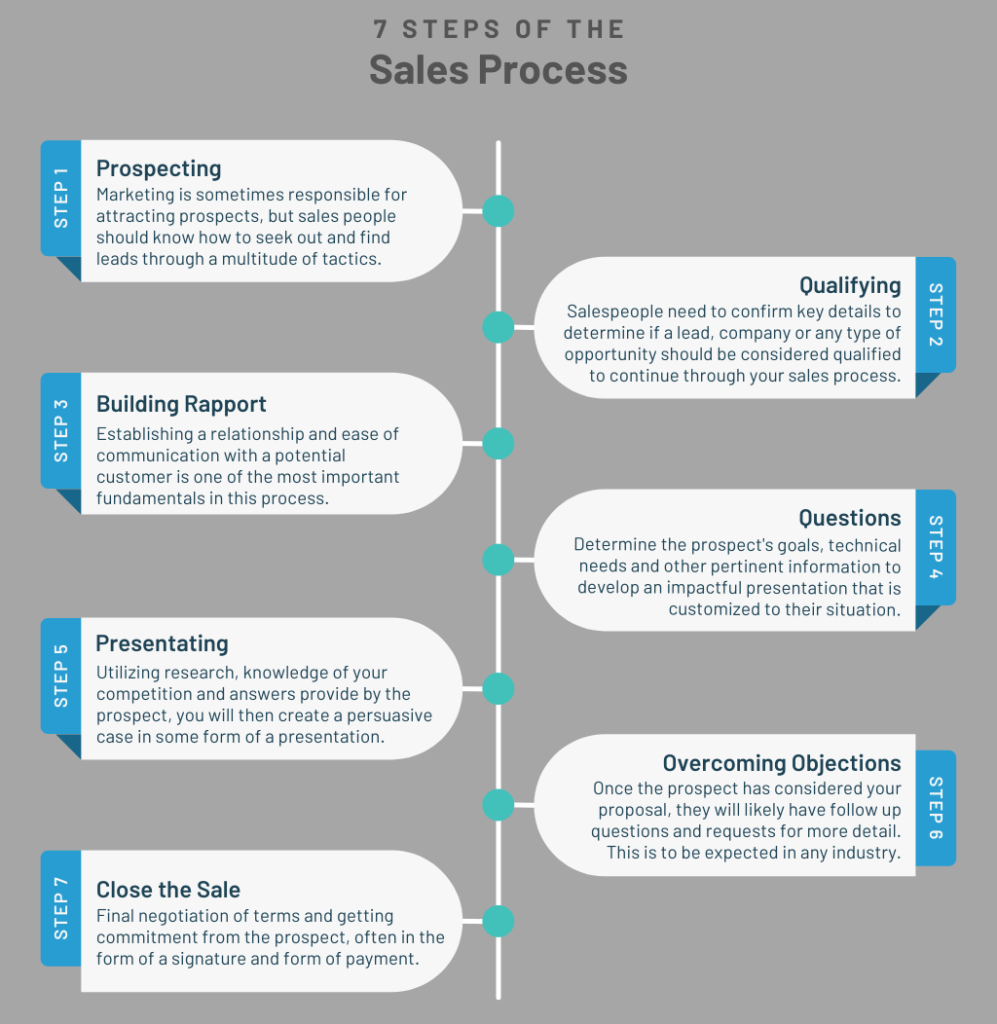Marketing Agency Sales Process
The first step in learning any craft is to familiarize yourself with the basics. With this, all of your strategies and skills can be directed and utilized at the proper time.

While similar to marketing, their is enough difference to the sales process that it requires it’s own steps. In learning how a sale is made, all other skills and techniques can be built on top of each step.
Having a framework to follow when starting out
Oftentimes when people start out their sales career in a small business, they are basically left to figure out how to sell on their own. Larger businesses usually have seasoned sales people that show them how to sell. But this too can be a limited education, since most of these larger companies do not allocate the time and resources to fully train someone and instead, utilize a mentorship program. This can be good, or not so good, depending upon the skill and motivation of the senior sales rep or sales manager.
Many corporate environments, have the benefit of a training department and have built established processes. However, these can often be rigid and developed around specific skillsets, with limited focus, to just their particular company process.
In creating this training, I’d like to provide the essentials to teaching you how the whole sales process works. Like many other industries, there are proven guidelines and steps that work well. By aligning your techniques and style to this process, you will achieve more success. In the long run, you will find that it saves you time, frustration and heartache.
More importantly, it will show you how to consistently close business and help you make money.
These are the sales steps:
- Prospecting
- Qualifying
- Rapport
- Questions
- Presentation
- Objections
- Close
Now don’t be overwhelmed at first. These steps, over time, will start to feel very natural. Even though they are steps to help you reach your goal, notice that they sit one on top of the other. This is because, each one is built off the previous steps before. In learning this process, you will understand why each is important and why there is an actual order to them.
Now let’s delve into, and get a little bit more definition for each of them.
Prospecting:
Of all of the steps in our industry, this one has been the most contentious over the years. As you work for multiple companies, you will find that expectations can vary. The smaller the business, the less likely they are to have dedicated marketing. You will end up finding that much of your time is spent on lead generation. A task that in larger companies, is usually assigned to a marketing team.
Either way, sales do not happen without leads. If you have the good fortune to have these leads generated by someone else, or you have to do it yourself, it is still the first step in the process. As a sales person, you may end up doing anything from cold calling to asking existing customers for referrals. But once you have a lead, it is now time to take it to the next step.
Qualifying:
This step can come in many forms. It can be a simple as looking up the company online and determining if they are the right type of customer for your business. Other times It may occur in the first meeting when you are determining their needs.
The key here is if you know that they do not qualify, you need to learn, to gracefully let go and move on. The point of this exercise is that you and the client will likely invest a decent amount of time throughout this process, And because of this, you want to make sure that it is not time wasted.
As a salesperson your largest commodity is your time. Unlike manufacturing or other established business practices, there is a lot of uncertainty to a salesperson’s job. And because of this we need to make sure we’re using this time as efficiently as possible.
Too often, salespeople pursue a deal because they are enamored by the revenue of a company or because they believe that they are a well known brand. Qualifying is about knowing if they are the right fit. As you progress through the rest of the steps, you will find that you can uncover more information, and that that qualifying is a continuous process, right through to the end.
Rapport:
If someone can easily evaluate and place an order online, then there would be no need for a salesperson in that particular company. But because many products and services, especially in B2B, do require more information and conversation, people end up buying from people. Which is where we come in.
Since human interaction is required in certain situations, it is a good idea to develop rapport as soon as possible. This consists of the clients having confidence in the salesperson, building trust, and feeling that they can have an open conversation about their company needs.
As simple as it sounds, people like to buy from people, that they like. Once again, this is a step, but it also continues, throughout the sale.
Questioning:
You can’t expect the client to know what information to provide. Yes they will have an idea of what you’re looking for but this gives you the opportunity to qualify and be able to put together a very streamlined presentation that fits their needs exactly.
When starting out at a new company, one of the first things that you should dedicate your time to is understanding your product or service well enough where you know exactly what to ask the client. This will help you to build a better presentation and it will increase the confidence that the client has in you.
Prospects will often judge your capability by the questions that you ask.
Presenting:
Once you have gotten to this stage, and done your research to address their questions, you will then put together a custom presentation to showcase your company as a solution to their issues. Most companies have what might be referred to as a boilerplate template. You might change a few items for the needs of the client.
Other opportunities may require a fully custom PowerPoint, just for them.
By the way, an actual presentation is not always needed in some cases. You may find yourself immediately responding to their questions over the phone, directly after asking your questions.
The purpose is to showcase that you have heard and addressed questions from the previous previous step and to present why yours is the best solution. This step is your sales pitch.
Overcoming Objections:
It is a bit cliché but overcoming objections is what can separate good sales people from great ones.
If you are receiving objections, follow up questions or requests for clarification, this means they are interested. This is why it is so important to have thought out objections and answers before they even come up. I would much rather overcome objections right there in the room, than have a lag time because I had to go back and ask for answers.
So if you want to be strong in this, ask others what objections they have heard before, and try to get really good at being able to address them with confidence.
Closing:
If you have gone through all of the previous steps successfully, and in the previous step, addressed all of their objections, then there is only one logical last step.
Now one of the easiest, but for some salespeople the most uncomfortable, skill is to actually to ask for the sale. Since you, as the salesperson, are in control of the process. you can’t assume that the client will automatically decide, ask for and then sign the contract. Yes, that will happen sometimes.
But if you want to consistently close business, you need to be able to get good at this. This is where seasoned sales people show their experience.
How the steps work together
As I mentioned earlier, these steps are built one on top of the other. This makes it very easy to go back in your steps, when a sale is stalled, or something changes.
If for example, you can’t seem to get them to close. It may be because you did not overcome some of the objections. Or perhaps you are a few days into the process, and a new decision maker is introduced in the conversation. This may cause you to go back more than one step to qualify this person as well, and build rapport.
In using these steps, you will always be in control of your side of this process. There are many variables outside of your control, and this will help you to manage the parts that you can.
The best part of this is when your manager now asks where you are with a specific opportunity, you will be able to confidently let them know… because you have this process to fall back on.
In more of these videos I will get into deeper detail and share tactics and strategies on how to maximize each of these steps. I hope you have found this helpful. Now get out there and sell.
Once these stages have been customized for your organization, it can be integrated into your systems development such as your CRM and can then be matched to your buyers journey within your marketing automation platforms.


